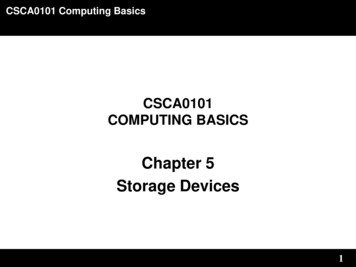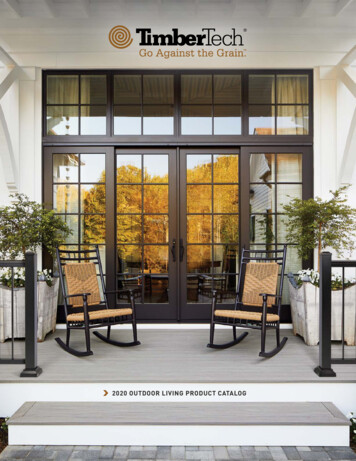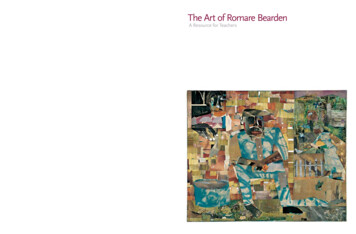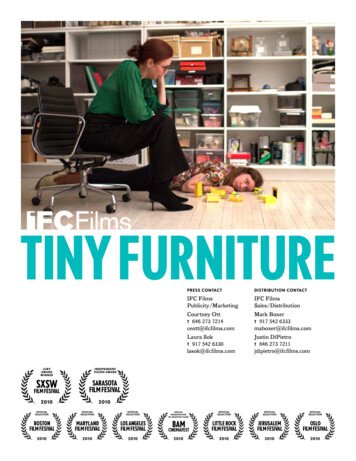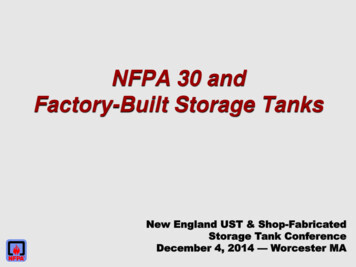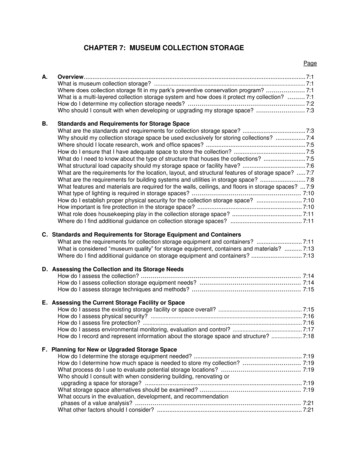
Transcription
CHAPTER 7: MUSEUM COLLECTION STORAGEPageA.Overview . 7:1What is museum collection storage? . 7:1Where does collection storage fit in my park’s preventive conservation program? . 7:1What is a multi-layered collection storage system and how does it protect my collection? . 7:1How do I determine my collection storage needs? . 7:2Who should I consult with when developing or upgrading my storage space? . 7:3B.Standards and Requirements for Storage SpaceWhat are the standards and requirements for collection storage space? . 7:3Why should my collection storage space be used exclusively for storing collections? . 7:4Where should I locate research, work and office spaces? . 7:5How do I ensure that I have adequate space to store the collection? . 7:5What do I need to know about the type of structure that houses the collections? . 7:5What structural load capacity should my storage space or facility have? . 7:6What are the requirements for the location, layout, and structural features of storage space? . 7:7What are the requirements for building systems and utilities in storage space? . 7:8What features and materials are required for the walls, ceilings, and floors in storage spaces? . 7:9What type of lighting is required in storage spaces? . 7:10How do I establish proper physical security for the collection storage space? . 7:10How important is fire protection in the storage space? . 7:10What role does housekeeping play in the collection storage space? . 7:11Where do I find additional guidance on collection storage spaces? . 7:11C. Standards and Requirements for Storage Equipment and ContainersWhat are the requirements for collection storage equipment and containers? . 7:11What is considered “museum quality” for storage equipment, containers and materials? . 7:13Where do I find additional guidance on storage equipment and containers? . 7:13D. Assessing the Collection and its Storage NeedsHow do I assess the collection? . 7:14How do I assess collection storage equipment needs? . 7:14How do I assess storage techniques and methods? . 7:15E. Assessing the Current Storage Facility or SpaceHow do I assess the existing storage facility or space overall? . 7:15How do I assess physical security? . 7:16How do I assess fire protection? . 7:16How do I assess environmental monitoring, evaluation and control? . 7:17How do I record and represent information about the storage space and structure? . 7:18F. Planning for New or Upgraded Storage SpaceHow do I determine the storage equipment needed? . 7:19How do I determine how much space is needed to store my collection? . 7:19What process do I use to evaluate potential storage locations? . 7:19Who should I consult with when considering building, renovating orupgrading a space for storage? . 7:19What storage space alternatives should be examined? . 7:19What occurs in the evaluation, development, and recommendationphases of a value analysis? . 7:21What other factors should I consider? . 7:21
G. Developing Storage Planning DocumentsWhy should I create planning documents for my collection storage space? . 7:21What is a Collection Storage Plan (CSP)? . 7:22What does the collection storage chapter or section of a CMP, CCS,or archival assessment contain? . 7:22Who can write a collection storage planning document? . 7:23How do I calculate the cost to prepare a storage planning document? . 7:23Where do I get funding to do a collection storage planning document? . 7:23Where do I include technical supporting information and drawings suchas floor plans in the storage planning document? . 7:23H. Using Storage Equipment to House ObjectsWhy is it important to use specialized museum storage equipment? . 7:24What types of equipment does the NPS use to store museum collections? . 7:24What are some other considerations when using museum storage equipment? . 7:25How does layering or containerizing create a stable environment? . 7:26How should I organize the equipment in my collection storage area? . 7:26What role does housekeeping play when selecting and organizing storage equipment? . 7:26I. Using Containers and Supports to House ObjectsWhy is it important to use storage containers and supports? . 7:26What kinds of containers and supports should I use for storing museum collections? . 7:27What role can specialized microclimates play in housing objects? . 7:28Where do I find additional information on techniques for storing museum objects? . 7:29J. Collection Storage in Historic StructuresWhat are the concerns about storing collections in historic structures? . 7:29Should I store collections in a historic structure or send them off-site? . 7:30How can I create the best possible collection storage in a historic structure? . 7:30K. Storage of Museum Collections Subject to the Native American Graves Protection andRepatriation Act of 1990 (NAGPRA)What is NAGPRA? . 7:31What types of items subject to NAGPRA are found in NPS museum collections? . 7:31Are there any special storage requirements for items subject to NAGPRA? . 7:31How should I store collections subject to NAGPRA? . 7:31Whom should I contact for assistance? . 7:33L. Selected Bibliography . 7:34M. List of Figures . 7:37
CHAPTER 7: MUSEUM COLLECTION STORAGEA. Overview1. What is museumcollection storage?Museum collection storage is both a physical space and an ongoing process. It is a dedicated space used for storing museum objects, naturalhistory specimens and archival materials. This space is designed orupgraded to meet standards and requirements for the preservation,protection, and accessibility of the collection.It is the ongoing process of containing, organizing and caring for thecollection while it is in storage. This involves evaluating andimplementing strategies and techniques to improve the condition andlong-term preservation of the collection.Each decision you make about storage should take into account how theconsequences of the decision will improve the protection and preservation ofcollections.2. Where does collectionstorage fit in my park’spreventiveconservation program?3. What is a multi-layeredcollection storagesystem and how doesit protect mycollection?Good collection storage is a major component of your park’s preventiveconservation and collections care program. It is essential to the long-termpreservation of your park’s museum collection. A well-planned and organizedstorage space reduces risks to the collection and provides accessibility.Deterioration, damage, or loss will be minimized if you implement: proper storage space, strategies and techniques good handling practices (see Chapter 6: Handling, Packing, and Shipping) effective security and fire protection (see Chapter 9: Security and FireProtection) good housekeeping practices (see Chapter 13: Museum Housekeeping) appropriate environmental conditions (see Chapter 4: Museum CollectionsEnvironment) an effective Integrated Pest Management program (see Chapter 5: BiologicalInfestations)A well-designed collection storage space that readily accommodates yourcollections combined with a rational, systematic approach to collectionsmanagement and good housekeeping will minimize or block risks to the collection.It will provide the collection the best possible protection from all agents ofdeterioration. See Chapter 3: Preservation: Getting Started for more informationabout the agents of deterioration.A multi-layered collection storage system is composed of successive layers ofprotective envelopes or enclosures, from the building itself to the equipment andcontainers that surround an object. The greater the number of layers, the moreprotection. Figure 7.1 illustrates the multi-layered approach to protecting an objectwith successive levels of containment. Although museum collection storagesituations vary, the variables that need to be considered to properly house acollection are the same. Evaluate each layer of the system and adapt itNPS Museum Handbook, Part I (2012)Museum Collection Storage7:1
to meet your collection’s preservation and protection needs.In the multi-layered approach, each level adds another layer of protection to thecollection by shielding it from the agents of deterioration. The more layers, thegreater the level of protection or “buffering” from the agents of deterioration. Thelayers of protection are: Building/facility envelope: exterior (outside/external) walls of the structurehousing the collection. Room/space envelope: walls of the room or space immediately enclosing thecollection. Equipment/storage furniture: storage furniture such as a cabinet with gaskets,map unit, or shelving unit housing the object. Container/housing: container housing the object such as a box, tray, or otherfully enclosed container. Packaging/wrapping materials: museum quality materials that cover and/orsupport the object inside of its container/housing, such as tissue, muslin, orpolyethylene foam.Figure 7.1. Multi-layered protection of an object4. How do I determine mycollection storageneeds?Become familiar with your collections and storage space. Evaluate each layer ofprotection. Become familiar with this chapter and complete the “NPS Checklist forPreservation and Protection of Museum Collections,” in Appendix F: NPS MuseumCollections Management Checklists. This checklist will help you evaluate yourcollection storage needs in the following areas:NPS Museum Handbook, Part I (2012)Museum Collection Storage7:2
5. Who should I consultwith when developingor upgrading mystorage space? facility and space requirements protection requirements (physical security and fire protection) environmental requirements museum equipment and container requirements housekeeping requirements Integrated Pest Management (IPM) requirementsComplete the Checklist by using the Automated Checklist Program of theManagement Reports module of Interior Collections Management System (ICMS).See Appendix J in the ICMS User Manual for more information. Use this checklistwhen making changes or additions to collection storage space.Consult with your regional curator, park facility manager, and a structural engineerand architect with experience in this area when building or updating your storagespace. They will provide specialized knowledge and guidance on new buildingsthat are designed to hold collections (purpose built structures), structures that areadapted to store collections (adaptive use) and historic structures that housecollections.B. Standards andRequirements forStorage SpaceStandards and requirements for collection storage space are based on National ParkService (NPS) policies and standards, Department of the Interior (DOI) andprofessional museum best practices.The NPS Management Policies, Section 5.3.1, states:“The National Park Service will employ the most effective concepts,techniques, and equipment to protect cultural resources against theft,fire, vandalism, overuse, deterioration, environmental impacts, andother threats without compromising their integrity or unduly limitingtheir appreciation by the public.”The Interior Departmental Manual Part 411 Policies and Standards for ManagingMuseum Collections, Chapter 3, provide departmental standards for museumproperty storage.1. What are thestandards andrequirements forcollection storagespace?The essential elements of NPS collection storage space standards and requirementsare summarized below. Safe and secure storage of museum collections requires dedicated space.Museum storage areas must only house museum collections. Separatemuseum storage from all other uses, including office space and research andwork areas. House collections in a dedicated space that has minimal penetrations andoptimum thermal performance. Museum storage space must be adequate to accommodate the particularcharacteristics and quantity of objects, specimens, and archival items in yourcollection. It must also provide adequate space to accommodate reasonableNPS Museum Handbook, Part I (2012)Museum Collection Storage7:3
growth of the collection over the next ten years. Organize the space to allow for the efficient use of curatorial equipment andtechniques, and to provide for effective access and optimum preservation ofthe museum collection. House objects in appropriate containers and package objects with appropriatematerials. Containerize collections to the extent possible to minimize the negative effectsof relative humidity and temperature fluctuations.Ensure the collection storage space is both suitable and sufficient for properstorage. Suitable space is planned space that has been determined to be adequatefor storing museum objects. Sufficient space is expandable space that providesroom for safe, non-crowded storage of the collection and allows room for futuregrowth.Outbuildings, closets, and unimproved basements and attics are not suitable space.These inadequate spaces do not contribute to the preservation and effective use of acollection. See Chapter 4: Museum Collections Environment for furtherinformation.Note: Recommendations provided in this chapter generally apply to structures thatare purpose built and or adapted to house museum collections, followed byrecommendations that apply specifically to historic structures.The “NPS Checklist for Preservation and Protection of Museum Collections"provides a detailed checklist of standards and requirements for collectionpreservation and protection, including collection storage space.2. Why should mycollection storagespace be usedexclusively for storingcollections?By separating curatorial office, work, and research spaces from the space housingthe collection, you minimize environmental impacts on the collections and lessensecurity risks. Do not combine storage space with other functions for reasons notedbelow. Collection security generally decreases; theft, mishandling, and vandalismincrease with storage room visitation and use. People working in the storage area increase the number of air exchanges thearea must undergo. Air exchanges cause temperature and relative humiditylevels to fluctuate, resulting in accelerated deterioration of objects. More airexchanges increase the load on climate control systems, leading to higherenergy costs and stress on passive control systems. Work areas often require lighting levels that may cause damage to unprotectedlight-sensitive objects due to the specific wavelength of the radiation, intensityor duration of the lighting. Lights are generally “off” in storage only spaces. Office equipment (copiers, computers) generate ozone, a pollutant damaging tocollections. Movement of people into and within the area tracks in soil and disperses dustinto the air, which in turn is deposited on surfaces of objects and equipment .NPS Museum Handbook, Part I (2012)Museum Collection Storage7:4
Potential for pest infestation increases. Accumulation of non-collections items increases the risk of fire and pestinfestation, and creates clutter that can lead to dirt/dust accumulation.Store flammable liquids and materials, curatorial supplies, audiovisualequipment, and other interpretive materials outside the museum storagespace to lessen clutter and thereby reduce the risk of fire.3. Where should I locateresearch, work andoffice spaces?Locate all research, work, and office spaces convenient to but not within thecollection storage space. Research is a fundamental use of a museum collectionand collections research space has its own specific requirements. Refer to theMuseum Handbook Part III, Appendix D: Guidance on Planning for a ResearchSpace, for guidance on a planning research space.4. How do I ensure that Ihave adequate spaceto store the collection?The storage space must be large enough to accommodate the existing collection aswell as the projected growth of the collection over the next 10 years. Whendesigning or upgrading your storage space, be sure that your space: houses individual objects appropriately and safely allows for the use of proper storage equipment and techniques incorporates aisles at least 48" wide between rows of equipment; this widthallows safe handling and movement of drawers, cabinet doors, and largerobjects ceiling height is sufficient to accommodate raised and stacked cabinets withoutinterfering with lighting and protection systems provides adequate access to the collections that is safe for staff and thecollectionsMake sure the space allows movement of personnel, equipment and objects in andout without hindrances such as inadequately sized doors; narrow, winding, or steepstairs; or passageways with low ceilings. Plan and organize your storage space tofacilitate access to the collection.5. What do I need toknow about the type ofstructure that housesthe collections?Different types of structures have different construction requirements. Therefore,installation of equipment such as fire and security systems, and storage furnitureneeds will also vary. A purpose built structure has different requirements than astructure that is adapted to house collections (adaptive use) or an historic structurethat houses collections. Consult with your facility manager, regional curator,historical architect and structural engineer during planning and implementation of astorage or construction project.In a historic structure, the best approach to providing suitable collection storagespace is to create a “room within a room.” This creates another layer of protectionfor the collections and protects the historic fabric of the structure. Particularlywhen strict environmental control is required, this strategyimproves the prospect of success because the equipment that controls the storagefacility environment has only the benign interior environment of the historicstructure to temper rather than the harsher exterior environment.NPS Museum Handbook, Part I (2012)Museum Collection Storage7:5
In pursuing such a strategy, configure the interior room in such a manner as to beas reversible as possible. Also, set it sufficiently away from the historic structure’sexterior envelope to provide a maintenance access passageway around its entireperimeter. This avoids inadvertent damage to the historic envelope attributable toaltered temperature or moisture gradients. It also allows for easy inspection andrepair of any other moisture or structure-related issues developing in the exteriorenvelope. Moreover, by providing an access passageway avoids the need to blockor alter the appearance of windows in the exterior envelope.6. What structural loadcapacity should mystorage space orfacility have?Collection storage space requires a greater structural load (weight) capacity thanoffice or living space. Storage equipment filled with museum objects can becomeextremely heavy. When housing collections in historic structures, remember thesestructures may not be able to bear large loads. Consult with your regional curator,park facilities manager, and a structural engineer and architect.Design or modify your storage facility or space to meet the following guidelines: Always consult a structural engineer to determine the suitability of a floor andthe placement of supports and equipment. Follow the International BuildingCode all new purpose-built structures, and the International ExistingBuilding Code for existing buildings. Various chapters within theInternational Existing Building Code deal with historic structures. Forfacilities not under direct ownership of the National Park Service, codesadopted by other jurisdictions may apply. Determine whether the load capacity of the existing structure is adequate toaccommodate your collection. The load will depend on the types and quantityof materials you plan to store. Use space capable of sustaining a live floorload of at least 150 pounds per square foot.Note that in historic structures it is often not possible to achieve the prescribeduniform live load capacity without unacceptable alterations. Floorsconstructed to a lesser load capacity may be considered if you install spot loadsupports (usually post supports from below) and arrange equipment to takeadvantage of existing structural supports (usually equipment arranged aroundthe perimeter of a room close to load bearing walls). To use this strategy, it isessential to engage in a continuous dialog with an historical architect andstructural engineer to attain an acceptable arrangement of storage furniturethrough an iterative process. Once such an arrangement is established, itshould not be altered without re-engineering. A live floor load of 350 pounds per square foot is desirable, especially forparticularly heavy collections such as paper-based materials such as archivesand herbaria, some fossil collections, metals, heavy equipment, and if you planto install a moveable aisle (compactor) storage system.Note that such a load capacity is rarely achievable in an historic structure.Consult a structural engineer and the equipment manufacturer whendetermining the required load rating for a floor supporting a moveable storagesystem or have objects of exceptional weight NPS Museum Handbook, Part I (2012)Museum Collection StorageDesign, construct and/or retrofit storage facilities to accommodate local orregional considerations, such as seismic activity or snow loads to minimizedamage to the collections and structure.7:6
7. What are therequirements for thelocation, layout, andstructural features ofstorage space?Consider reinforced concrete or masonry construction with a wind load ratingof 110 miles-per-hour or higher for new construction of stand-alone purposebuilt storage facilities in areas susceptible to severe wind conditions. Fastenroofs to the wall and/or foundation structural components so the roof canwithstand hurricane force winds.To adequately preserve and protect the collection, locate and construct collectionstorage facilities and spaces to meet the following requirements: Locate the storage space outside the 100-year floodplain. This is inaccordance with Executive Order 11988, "Floodplain Management," May 24,1977 (42 USC 4321) and Procedural Manual 77-2: Floodplain Management. Store only collections in the space. Local and national building codes usuallyrate collection storage space as “storage occupancy.” Locate work, office,research (“human occupancy”), and supply storage areas close to, but notwithin, the storage space. Space is sufficient for the movement of staff, equipment, and objects in andout without hindrances (e.g., low ceilings; inadequately sized doors; or narrow,winding, or steep stairways). Space is large enough to accommodate thecurrent museum collection and anticipated growth for at least the next tenyears. Use space that is constructed of fire-resistant or fireproof materials. Coverinterior wood framed walls and ceilings with gypsum wallboard or othermaterial to achieve a minimum one-hour fire rating (some codes may require atwo-hour fire rating). In historic structures, consider creating a “room within aroom,” using fire-resistive materials for the newly-inserted construction. In a purpose built structure, do not include windows on an external envelopewall. Use as few doors as practical to enhance security and environmentalcontrol, but not so few as to be in violation of health, safety and fire codes.See National Fire Protection Association NFPA 101, “Life Safety Code,” 2009Edition, and OSHA Standard 1910.36, “Design and construction requirementsfor exit routes.” Create a “room within a room” to house collections awayfrom the exterior envelope to minimize environmental fluctuationsandcondensation and place offices adjacent to exterior walls. If the space has windows, make sure they are physically blocked and insulatedin a reversible manner to eliminate natural light, reduce environmentalfluctuations, and enhance security. In an historic structure, this must beaccomplished in such a manner as to be undetectable from the exterior, and toallow ready access to the window for maintenance purposes. Insulate the space so it will maintain a stable environment that protects theobjects from adverse temperature and relative humidity conditions and damagefrom biological infestations. Insulate walls to a minimum R-19 rating and theceiling to a minimum R-30 rating. Install an adequate vapor barrier in walls, ceilings, and floors in a purpose builtmuseum structure.Note: Consult with a specialist in this area before installing a vapor barrier inNPS Museum Handbook, Part I (2012)Museum Collection Storage7:7
an extant facility as vapor barriers can inadvertently create moisture and moldproblems. . Use space with as few exterior walls as practical. This will minimize thechance of condensation on walls and windows during seasonal and diurnaltemperature changes, enhance security, and increase energy efficiency. Keep areas adjacent to the structure’s exterior free of trees, shrubs, or otherplants. Plantings close to or touching exterior walls provide a habitat for peststhat may then migrate into the structure. Install a sanitary barrier of smallpebbles over a geotextile and have surrounding dirt slope away from thestructure to minimize moisture seepage into the structure.Consult with a specialist before installing a vapor barrier in buildings, inparticular, ones that have crawl spaces with exposed dirt to avoid introducingmoisture problems. The specialist will need to determine whether a vaporbarrier in this location will have the unintended effect of encouragingadditional capillary uptake of ground moisture into adjacent masonry elements.Also, the specialist will need to recommend a means for removal of moisturethat accumulates on top of the vapor barrier due to infiltration or condensation.If possible, install a slab on grade as described below. However, in a historicstructure, use a more reversible approach.8. What are therequirements forbuilding systems andutilities in storagespace? Install rigid foam insulation and a vapor barrier in concrete floors on grade forpurpose built structures. Make sure the level of the top of the concrete slab isat least 6" above the grade level of the soil. Consult a specialist beforeinstalling a vapor barrier to avoid inadvertently creating a moisture problem. Require frame walls to be a minimum of 6" thick, constructed with 6" metal orwood studs. This thickness of wood-frame wall construction providesstructural strength and is capable of accommodating the required insulation. Use metal hollow-core or wooden solid-core doors with a good fire rating.Equip entry doors with a mortise lockset or a key-in-knob lock combined witha separate deadbolt lock. Place door hinges on the interior side of the door. Ifhinges are located on the exterior of the door, use non-removable hinge pins. If the historic or adapted structure requires wood underlayment beneath newresilient flooring, use only softwood plywood as it produces minimal offgassing or use products that have minimal or no noxious gases. Other types ofunderlayment material may contain adhesives that off-gas significant amountsof formaldehyde, wh
tomeet your collection’s preservation and protection needs. In the multi-layered approach, each level adds another layer of protection to the collection by shielding it from the agents of deterioration. The more layers, the greaterthe level of protection or “buffering” fromthe agents of det


